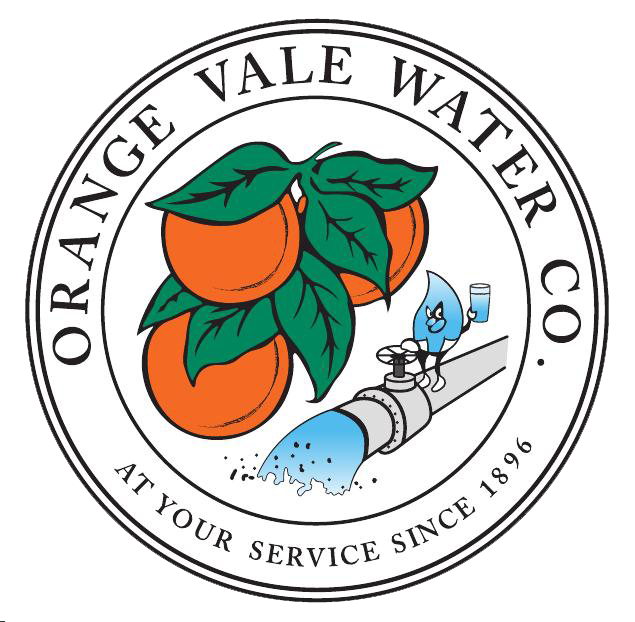Our History
The Orange Vale Water Company is a located in the northeast portion of Sacramento County, approximately 20 miles north of downtown Sacramento. The service area consists of 3,078 gross acres of residential, commercial, and agricultural land use. Approximately 60 percent is developed for single-family and multi-family residential housing, while approximately 10 percent is developed for commercial use. The remaining land within the service area is undeveloped. the service area is within the incorporated are of Sacramento County, except for approximately 10 acres which are within the City of Folsom. There are currently 4,486 members who possess a total of 5,159 shares within the Company. This includes 2 full time agricultural customers and 40 commercial customers.
Articles of Incorporation were filed May 29, 1896 for the Orange Vale Water Company. It is a mutual water company, owned and operated by the consumers who are shareholders in the company. In 1994 the Water Company adopted the California Non-Profit Mutual Benefit Corporation Law, and its shareholders became members.
The Company is governed by a Board of Directors composed of five members who service two-year terms of office. Two Directors are elected in even years and the other three are elevated in odd years. These Directors choose the president and vice-president of the Board. A general manager, maintenance personnel, and support staff are employed to handle the Company’s operation.
“The Orange Vale Water Company is a unique water service provider that has followed the original concept of its founders – a mutual company serving the needs of the people.” Frederick S Tomich
This portion of California was once a vast, unfenced range for cattle, which were driven to whatever water source could be found. These were the American River, springs and, in some seasons, rain-filled water holes.
The Mexican government owned the land and, to collect tax from it, issued claims to private owners. One early record shows that on December 24, 1844, J.P.D Dedmond filed a claim from the Mexican Government. This claim, called the Santa Juanita Grant, includes the land now known as OrangeVale. Other owners appear, and in 1881 J.T. Cardwell bought 4,400 Acres of this grant for six dollars per acre. This land extended from what is now Oak Avenue on the North and Hazel Avenue on the East, South to the American River.
In 1887, Cardwell sold the southern 2,220 acres of his land to V. McClatchy, George S. Mott, Thomas B. Hall, P.C. Drescher, and H. Weinstock. With these men as officers, a group of some 36 Sacramento businessmen organized the Orangevale Company to sell small acreages of land to settlers. They purchased additional land, extending from Hazel Avenue to Kenneth Avenue, south to Fair Oaks and North to Oak Avenue. This colony – the first successful Colony in California – was named “Beautiful OrangeVale Colony” by P.C. Drescher.I
n 1888, the OrangeVale Colonization Company purchased the land from the OrangeVale Company and laid it out in ten-acre tracts. That spring, 130 acres of land were planted to grit trees imported from Florida. More water was needed, and until pipes could be laid, the OrangeVale Colonization Company hauled water from ditches in big tanks pulled by four-horse teams.
The first ditch through OrangeVale came as far as Pecan Avenue, then south to Mississippi Bar, with its reservoir at Rock Corral and the Cardwell Ranch. The second ditch ran from a reservoir on the Cox Ranch to Main avenue and then ran straight south to Mississippi Bar. A branch came westward, crossed Tract 190 on Pecan Avenue in flume and then ran into a ditch to Beech Avenue, and south to Sailor Bar on the American River.
These ditches were originally built to deliver water to the gold miners. In 1854, The America River Ditch Company commenced work on a main ditch, completing it in 1857 to Big Gulch (now know as Ashland). This ditch ended at Big Gulch, but smaller ditch, named “Eureka,” ran from there to Mississippi Bar thorough OrangeVale.
In the spring go 1887, the owners of “Eureka” pains on dollar per tree to put out 10,000 orange trees one mile north of OrangeVale. They mortgaged the ditch to borrow $10,000 from Clarke and Cox. The trees all froze that winter, and Clarke and Cox took over the ditch. In 1889, the first pipes from the North Fork Ditch Company were laid in OrangeVale.
Beginning in 1888, the North Fork Ditch Company served water through its ditches and pipes to Orange Vale Colonization Company, later extending service to the Fair Oaks and Citrus Heights Irrigation Districts. When Folsom Dam was constructed, parts of the North Fork Ditch and Hinkle reservoir were within the Dam’s reservoir area.
Negotiations between the North Fork Ditch Company and the Corps or Engineers resulted in an agreement and that the Bureau of Reclamation would deliver, without charge the 33,000 acre/feet of water for which the company held water rights. In 1955, the ditch was abandoned and water from the Folsom Dam was delivered to the new Hinkle Reservoir.
The people served by the North Folk Ditch Company felt that they should own these water rights and distribution system. In 1954, the San Juan Suburban Water District was formed by the Orange Vale Water Company, Fair Oaks Irrigation District, Citrus Heights Irrigation District, North Fork Ditch Company;s service area, and certain dry lands, a total of 26,000 acres.
In 1954, the District issued revenue bonds to buy out the North Fork Ditch Company. Today, the San Juan Water District is a master district, serving water at wholesale to Orange Vale Water Company as well as other water districts.
